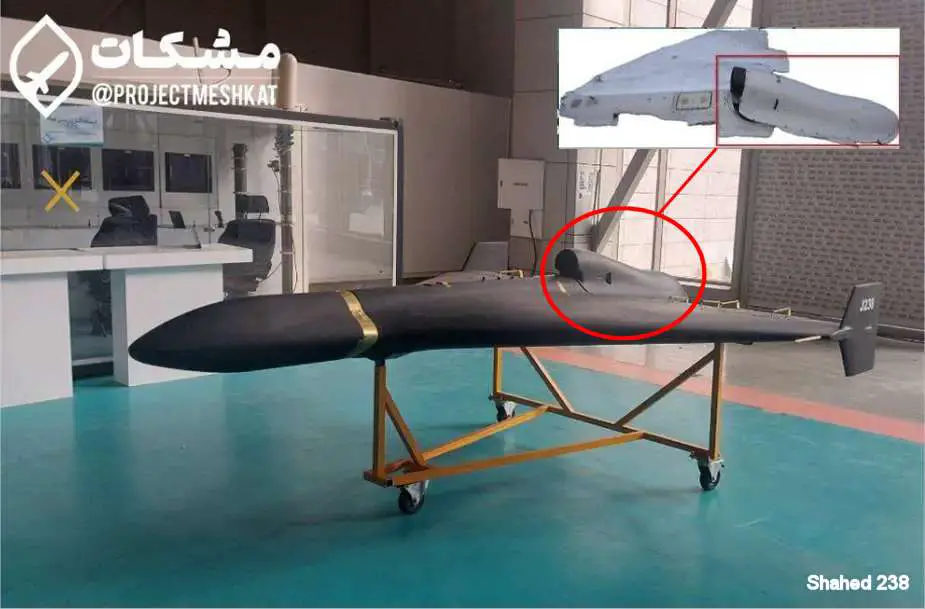On January 8, 2024, a member of the Ukrainian armed forces announced via its social media channel: the first successful interception of an Iranian-origin Shahed-238 drone. This drone, equipped with a jet engine and capable of speeds up to 500km/h, would have been shot down over central Ukraine, marking its first appearance in the conflict.
Follow Army Recognition on Google News at this link

Iranian-origin Shahed-238 drone would have been shot down by Ukrainian air defense (Picture source: Meshkat/ Ukraine social media)
Images of the downed drone's debris were initially shared on a Telegram channel, reportedly run by an officer from the Ukrainian Armed Forces. The photos display several white fragments of the drone, including parts that appear to be from the drone's top-mounted engine intake. Additionally, the wreckage seems to contain a small jet turbine and some type of control unit. The most prominent marking visible on the exterior of the drone is "MJO" or "MJ0", written on a part of its body. It is important to highlight that the first Russian kamikaze drone of the Shahed-238 type shot down bore the distinctive marking "MJ 0". This detail strongly suggests that the drone is of Iranian manufacture, given the "M" series designation.
The Iranian-made Shahed-238 is an advanced version of the Iranian kamikaze drone Shahed-136, used by Russia in Ukraine, and incorporates significant improvements. A notable upgrade from the Iranian Shahed-136 model is the Shahed-238's ability to autonomously navigate towards its targets. This feature increases the operational flexibility of the drone compared to the manual operation required by the older prototype. This enhancement extends the range of the Iranian drone and reduces the need for relay stations near the target.
From a military standpoint, Russia's deployment of the jet-powered kamikaze drone Shahed-238 on the Ukrainian battlefield could offer several advantages over the used Shahed-136.
Visually, the Shahed-238 introduces several significant improvements, such as an engine cowling and an increased number of actuators. The engine cowling has the potential to enhance the drone's aerodynamics, potentially affecting its speed, maneuverability, and energy efficiency, critical factors in military drone applications. Moreover, this can reduce the drone's radar and infrared signatures, making it less detectable by enemy radars and infrared sensors.
The inclusion of eight actuators, as opposed to the four in the Shahed-136, represents another key difference. Actuators play a vital role in controlling various aspects of a drone's flight, including stability, maneuverability, and payload management. The increased number of actuators provides improved stability, finer control of the drone's movements, and greater resilience to external disturbances.
The use of the Shahed-238 enables Russia to conduct deep-strike targeted operations within Ukrainian territory. This new drone allows them to be launched from deep within Russian territory, where launch sites are more challenging for Ukraine to target, and yet they can still reach several Ukrainian cities.
As said above, it is important to highlight that the first Russian kamikaze drone of the Shahed-238 type shot down bore the distinctive marking "MJ 0". This detail strongly suggests that the drone is of Iranian manufacture, given the "M" series designation. Currently, it is uncertain whether the Russian Federation plans to transfer the production of this model to its territory, similar to what was done with the Geran-2 drone. As a reminder, Russia had announced at the beginning of 2023 its intention to bolster its defense production capacity. This follows a similar strategy adopted for the Iranian Shahed 136 drone, initially delivered by Iran, and then mass-produced in Russia under the name Geran-2.
However, the reliance on a drone from the Iranian industry suggests that despite the increase in its military production, Russia remains dependent on arms imports from countries such as Iran and North Korea.















